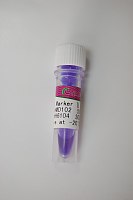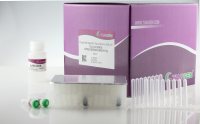Polony DNA Sequencing
互联网
- Abstract
- Table of Contents
- Materials
- Figures
- Literature Cited
Abstract
Polony DNA sequencing provides an inexpensive, accurate, high?throughput way to resequence genomes of interest by comparison to a reference genome. Mate?paired in vitro shotgun genomic libraries are produced and clonally amplified on microbeads by emulsion PCR. These serve as templates for sequencing by fluorescent nonamer ligation reactions on a microscope slide. Each sequencing run results in millions of 26?bp reads that can be aligned to the reference genome, allowing the identification of differences between sequences.
Keywords: DNA sequencing; high throughput; polony sequencing; resequencing; sequencing by synthesis
Table of Contents
- Basic Protocol 1: Construction of a Shotgun Paired‐Tag Genomic Library
- Basic Protocol 2: Emulsion PCR of Paired‐Tag Library on Microbeads
- Basic Protocol 3: Enrichment for Amplicon‐Bearing Beads
- Basic Protocol 4: Casting A Polony Bead Array
- Basic Protocol 5: DNA Sequencing by Ligation With Degenerate Fluorescent Nonamers
- Support Protocol 1: Titration of Template for Clonal Amplification by ePCR
- Reagents and Solutions
- Commentary
- Literature Cited
- Figures
- Tables
Materials
Basic Protocol 1: Construction of a Shotgun Paired‐Tag Genomic Library
Materials
Basic Protocol 2: Emulsion PCR of Paired‐Tag Library on Microbeads
Materials
Basic Protocol 3: Enrichment for Amplicon‐Bearing Beads
Materials
Basic Protocol 4: Casting A Polony Bead Array
Materials
Basic Protocol 5: DNA Sequencing by Ligation With Degenerate Fluorescent Nonamers
Materials
Support Protocol 1: Titration of Template for Clonal Amplification by ePCR
|
Figures
-
Figure 7.8.1 General procedure for polony sequencing. A paired‐tag genomic library is used as template for emulsion PCR on microbeads to generate polymerase colonies (polonies). The beads are cast on a coverslip in a thin layer of polyacrylamide, and put through iterative cycles of single‐base sequencing. View Image -
Figure 7.8.2 Schematic of the 135‐bp bead‐bound template and sequences of oligonucleotides used in sequencing reactions (). For each reaction, the combination of anchor primer(s) and fluorescent nonamers is specified by the position in the tag being sequenced. All anchor primers should be synthesized with deoxyuridine to allow enzymatic removal of the primers. Fluorescent nonamers should be synthesized by Integrated DNA Technologies (IDT) with fully degenerate positions hand mixed to ensure equal ratios of each nucleotide at each position. The T30 sequence is shown as T30L and T30R to emphasize that the sequencing primers do not bind the full length of T30. Abbreviations: DMA and DMB, distal minus A and B strands; DP, distal plus; PM, proximal minus; PPA and PPB, proximal plus A and B strands; PR1‐F and PR1‐R, forward and reverse PR1 primers. View Image
Videos
Literature Cited
| Literature Cited | |
| Diehl, F., Li, M., Dressman, D., He, Y., Shen, D., Szabo, S., Diaz, L.A. Jr., Goodman, S.N., David, K.A., Juhl, H., Kinzler, K.W., and Vogelstein, B. 2005. Detection and quantification of mutations in the plasma of patients with colorectal tumors. Proc. Natl. Acad. Sci. U.S.A. 102:16368‐16373. | |
| Diehl, F., Li, M., He, Y., Kinsler, K.W., Vogelstein, B., and Dressman, D. 2006. BEAMing: Single‐molecule PCR on microparticles in water‐in‐oil emulsions. Nat. Methods 3:551‐559. | |
| Dressman, D., Yan, H., Traverso, G., Kinzler, K.W., and Vogelstein, B. 2003. Transforming single DNA molecules into fluorescent magnetic particles for detection and enumeration of genetic variations. Proc. Natl. Acad. Sci. U.S.A. 100:8817‐8822. | |
| Li, M., Diehl, F., Dressman, D., Vogelstein, B., and Kinzler, K.W. 2006. BEAMing up for detection and quantification of rare sequence variants. Nat. Methods 3:95‐97. | |
| Mitra, R.D. and Church, G.M. 1999. In situ localized amplification and contact replication of many individual DNA molecules. Nucleic Acids Res. 37:e34. | |
| Mitra, R.D., Butty, V.L., Shendure, J., Benjamin, R., Williams, B.R., Housman, D.E., and Church, G.M. 2003. Digital genotyping and haplotyping with polymerase colonies. Proc. Natl. Acad. Sci. U.S.A. 100:5926‐5931. | |
| Sanger, F., Nicklen, S., and Coulson, A.R. 1977. DNA sequencing with chain‐terminating inhibitors. Proc. Natl. Acad. Sci. U.S.A. 74:5463‐5467. | |
| Shendure, J., Mitra, R.D., Varma, C., and Church, G.M. 2004. Advanced sequencing technologies: Methods and goals. Nat. Rev. Genet. 5:335‐344. | |
| Shendure, J., Porreca, G.J., Reppas, N.B., Lin, X., McCutcheon, J.P., Rosenbaum, A.M., Wang, M.D., Zhang, K., Mitra, R.D., and Church, G.M. 2005. Accurate multiplex polony sequencing of an evolved bacterial genome. Science 309:1728‐1732. | |
| Siebert, P.D., Chenchik, A., Kellogg, D.E., Lukyanov, K.A., and Lukyanov, S.A. 1995. An improved PCR method for walking in uncloned genomic DNA. Nucleic Acids Res. 23:1087‐1088. | |
| Turner, D.J., Shendure, J., Porreca, G., Church, G., Green, P., Tyler‐Smith, C., and Hurles, M.E. 2006. Assaying chromosomal inversions by single‐molecule haplotyping. Nat. Methods 3:439‐445. | |
| Zhang, K., Zhu, J., Shendure, J., Porreca, G.J., Aach, J.D., Mitra, R.D., and Church, G.M. 2006. Long‐range polony haplotyping of individual human chromosome molecules. Nat Genet. 38:382‐387. | |
| Zhu, J., Shendure, J., Mitra, R.D., and Church, G.M. 2003. Single molecule profiling of alternative pre‐mRNA splicing. Science 301:836‐838 . |






